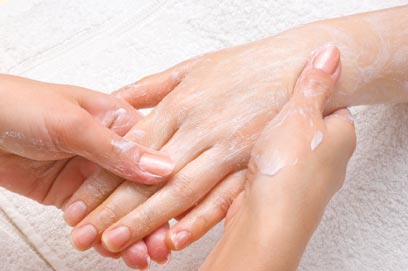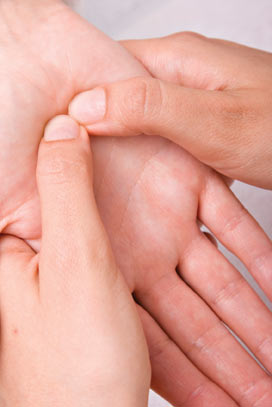
There is growing awareness of the value of therapeutic massage and skilled touch for elders with dementia. More and more elder-care communities are incorporating the services of a licensed massage therapist, but caregivers of all kinds possess the power of touch to help manage behaviors and improve the quality of life of the elders they care for.
Long term care providers are being challenged like never before to come up with innovative ways to care for the rising numbers of older adults living with Alzheimer’s disease and other forms of dementia.
In this era of cost consciousness, skilled touch is an inexpensive and non-invasive intervention that can easily be administered by both professional and lay caregivers.
Human Touch In Caregiving
People are naturally drawn to comfort infants with touch. What about those elders living with severe dementia? Are caregivers as willing to comfort with the same kind of touch offered to a baby? Most likely not. It seems that in society today, the willingness to touch elders diminishes. There is a culture that deems the aged and ill as “untouchable” in many ways.
Touch is one of the most basic human needs and remains constant for a lifetime. Elders with dementia are often deprived of nurturing touch and meaningful physical closeness that can help them thrive.
Touch in the form of sensitive massage or attentive holding has the power to ease physical, emotional, and spiritual discomfort. In the words of anthropologist Ashley Montagu, the most important and neglected need is the need for tactile stimulation. “The elderly often have impaired hearing, visual acuity, mobility, and vitality problems that can make them feel helpless and vulnerable…it is through the emotional involvement of touch that one can reach through the isolation and communicate love, trust, affection, and warmth,” she said.
Since touching the hands is so familiar, hand massage may be gladly accepted by elders in long term care. A simple way to ask permission to give the hand massage is to offer to put lotion on elders’ hands.
The following simple five-minute hand massage protocol can easily be incorporated into care routines by staff or family caregivers. Following are some techniques:
- Preparation. Hold the hand of the resident receiving the touch, creating a connection and helping the person become focused or centered.
- Application of technique. Apply hypo-allergenic massage lotion. Give each of the fingers a few gentle squeezes from the base to the fingertip, pausing periodically to make circular motions. Turn the hand over and make tiny circular motions on the palm of the hand with the thumbs and massage the soft, fleshy areas on the palm.
- Closing. Finish by thanking the recipient while holding both of his or her hands and sharing eye contact.
Universal precautions are important in any hands-on care. Caregivers should wash hands before and after giving a hand massage. Use caution and proceed with care when any of the following conditions are present: thin, dry skin; impaired range of motion; fragile bones; and conditions that contraindicate even gentle hand massage, such as bruises, cuts or openings in the skin, severe pain, edema, and inflammation.
Mutual Benefits
Even in a five-minute touch session there are mutual benefits for the elder and the caregiver.
For the elder, focused touch and sensitive massage can do the following:
- Ease aches and pains;
- Encourage greater joint flexibility;
- Provide sensory stimulation, resulting in increased body awareness;
- Induce a relaxation response, increasing feelings of calmness;
- Support psychosocial well-being and decrease feelings of isolation; and
- Acknowledge one’s worth regardless of the condition of the body or mind.
The caregiver may experience decreased feelings of helplessness, less resistance by the resident in assisting with personal care and mobility tasks, the ability to more easily engage the elder in activities, a nonverbal way to redirect behavior or actions and reassure the person who is confused, and greater feelings of satisfaction and meaning in the work of caregiving.
Research Supportive
While there is a need for further research, studies indicate that the use of some forms of massage are effective in managing challenging behavior often exhibited by elders living with Alzheimer’s disease and other forms of dementia.
The Remington Study, published in Nursing Research 2002, examined whether modifying environmental stimuli by the use of calming music and hand massage affects agitated behavior in persons with dementia. The

subjects were exposed to 10 minutes of either calm music, hand massage, a combination of the two, or no intervention. Results demonstrated that both calm music and hand massage reduced verbal agitation and that the benefit was sustained for up to one hour.
A 1995 Geriatric Nursing study by Snyder, et al., explored the idea of whether administering hand massage before care activities that were often associated with agitative behaviors would reduce the frequency and intensity of these behaviors during care activities.
A five-minute hand massage was performed on residents in the morning and afternoon for 10 days. Results showed that it decreased the frequency and intensity of agitated behavior during morning care routines, although not during evening care. Staff reported that reducing the intensity of the behavior made it easier to care for the elders.
A study published in the International Journal of Nursing Practice (1998) explores use of hand massage in an adult day-care center. Hand massage and essential oils were applied by staff and family members. The results were increased alertness; improved sleep; and decreased agitation, withdrawal, and wandering among the residents who received the hand massages.
Family caregivers also reported decreased stress, improvement in sleep, and less difficulty in managing the elder’s difficult behaviors.
A Case In Point
A case study in Geriatric Times illus-trates the impact of incorporating skilled touch in the form of sensitive hand massage for an 81-year-old woman called Mary, who resided in a skilled nursing facility for seven months.
Prior to admission to the facility, she was cared for in her daughter’s home. Mary had Alzheimer’s disease, anxiety, dementia with behavior disorder, insomnia, osteoarthritis, osteoporosis, and recurrent urinary tract infections.
She also required a wheelchair and had increasing difficulty communicating her needs because she could not find the appropriate words to express herself. Mary had also recently begun to yell out and, at times, bang on her wheelchair for long periods of time.
She attended group activities, but her behavior was upsetting to the others, so she often was removed from the group. She had difficulty sleeping and was often more anxious at night, which increased her yelling behavior.
The nurse assistants and activities staff administered hand massages to Mary three times per day. Each session was five to 10 minutes and typically took place in the morning after breakfast, before group activities, and in the evening.
Mary was receptive to having lotion applied to her hands and was responsive to the one-to-one attention.
Following one week, the activity director reported that Mary was able to remain in more group activities without disruptive yelling and only occasional banging on her wheelchair. She was more engaged during self-care activities, and she had decreased restlessness at night.
This scenario illustrates that focused touch and sensitive massage may be used by any caregiver as an easy-to-learn and effective tool in dementia care.
Ann Catlin, OTR, LMT, is a nationally certified and licensed massage therapist, Compassionate Touch Practitioner, and a registered occupational therapist. Catlin directs the Center for Compassionate Touch, a training organization. She can be reached at www.compassionate-touch.org.